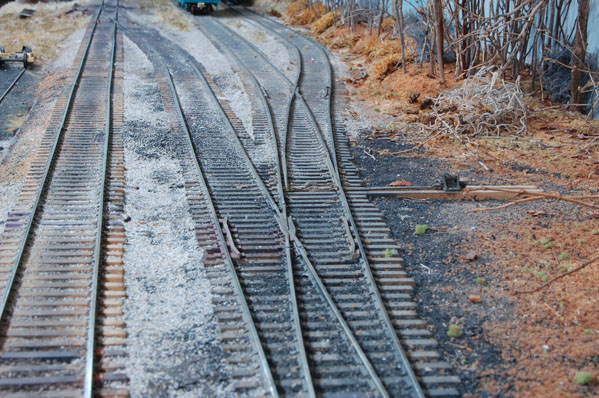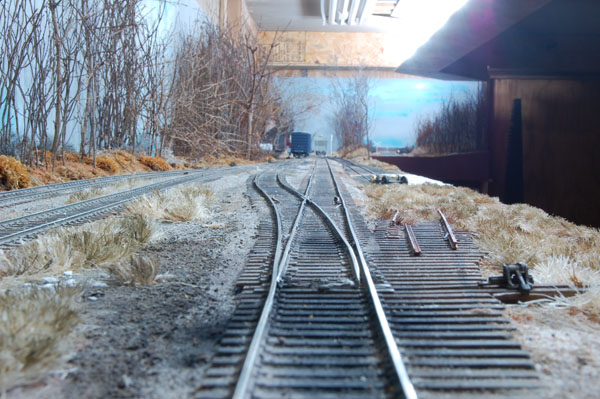I read a post online somewhere, in which the author commented that nothing beats turnouts with scratchbuilt frogs because of the smooth flowing lines possible. He further contended that getting a smooth flow was more difficult with commercial castings. I respectfully disagree with the second assertion. If one is speaking of commercial turnouts with their rigid, inflexible geometry, then I do agree. Smooth, flowing track is more difficult to achieve when you’re locked into the fixed lines from commercial products.
However, prototype turnouts are also made with cast frogs and points, and I submit that they have no problem with getting a smooth flow to the track. In my view, it isn’t the use of commercial frog castings that inhibit smoothness. As proof I offer two photos from my own layout. I use point and frog castings from American Switch and Signal. Photo 1 shows two no. 8 turnouts and Photo 2 is a No. 10. You be the judge about how smooth and flowing the lines through each turnout are.
Regards,
Mike


Great trackwork Mike and a great point. While trackwork may seem to flow better using handmade components in turnouts, in fact US practice is to have the frog area of the turnout straight and unless the turnout is VERY old, they use cast manganese frogs, because they wear better than steel. They do use curved frogs in England, but if we are modeling a US prototype, we really should be using drop in components, at least for the frog, and really it will save USA lot of time if we do that. There are, of course, prototypical examples of drop in turnouts, because, to be honest, the prototype would rather have a turnout be straight anyway if possible, but this is not necessarily the norm.
If we have the parts available, we should really be building things the way the prototype does if we can, after all, after over 150 years, you would think that they would know how to do something efficiently.
“..If we have the parts available, we should really be building things the way the prototype does if we can, after all, after over 150 years, you would think that they would know how to do something efficiently.”
Couldn’t agree more. There really is no excuse these days. Outstanding quality supplies are readily available at reasonable cost. The only thing holding someone back is their unwillingness to try or learn something new.
Mike Cougill
“Couldn’t agree more. There really is no excuse these days. Outstanding quality supplies are readily available at reasonable cost. The only thing holding someone back is their unwillingness to try or learn something new.”
Which is really kind of funny because building a turnout using drop in components, a la the prototype, is actually easier to do than to try to make the components yourself. It will also lend itself to a better looking and better operating turnout with less work. Who wouldn’t want that?
Yes, exactly. That’s been my experience with castings. Much easier to use than building frogs and points from scratch.
Mike